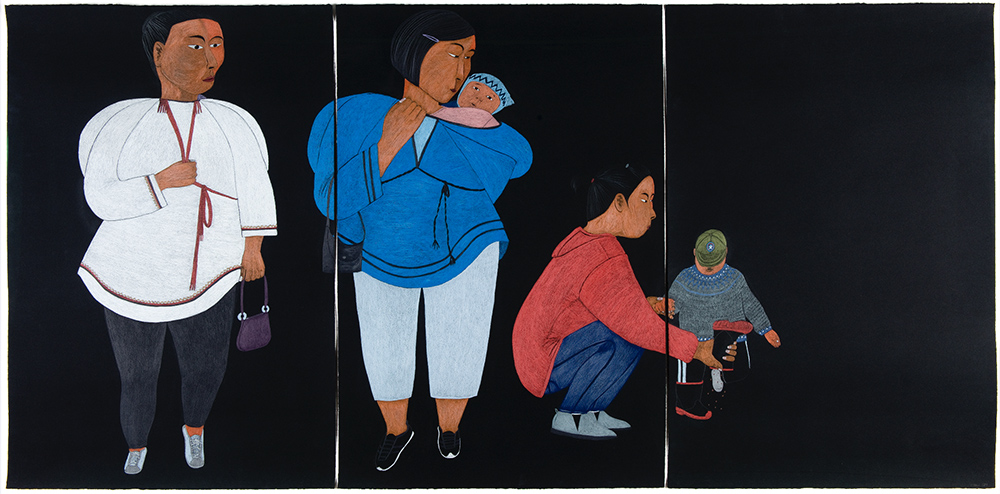How One Drawing Speaks to the Next Generation of Inuit
Inuit Art Foundation | February 07, 2022
Categories: news
Exploring the Global Affairs Canada Visual Art Collection
Feb 07, 2022
by Kerry Goodfellow

Ningiukulu Teevee is one of many contemporary Inuit artists in the Global Affairs Canada Visual Art Collection whose work personifies the theme of legacy. Born in 1963, Teevee is largely a self-taught artist. She released her first print in the 2004 Cape Dorset Annual Print Collection and has been a mainstay in the Dorset Fine Arts roster ever since. Teevee is an established cultural ambassador for the remarkable talent produced in Kinngait Studios. She was featured in a 2017 solo exhibition, Ningiukulu Teevee: Kinngait Stories organized by the Winnipeg Art Gallery and presented at the Canada Gallery in the Canadian Embassy in Washington, DC.
Her work in both printmaking and drawing are characterized by her innate sense of composition, bold colour, fluid use of patterning and, above all, her ability to share stories infused with humour. The majority of Teevee’s drawings in the collection incorporate stories and legends passed on to her by Elders in her community—she notes the late Mialia Jaw (1934–2006) as a great inspiration. However, her large-scale tripartite pastel drawing, Generations(2017), is unique among a body of works rooted in everyday life and portrayed with a strong female perspective, highlighting the bonds of family and community.
Teevee depicts two women wearing amautiit, leggings, sneakers and carrying purses. The woman in blue gazes at the child she carries in her amauti. The eldest child is a young girl dressed in a hoodie and jeans, who lovingly helps the little boy wearing a baseball hat empty dirt out of his rubber boot. The scene captures life in Kinngait, providing insight into the daily reality of a resilient culture that blends traditional and contemporary elements and influences from the South.
Teevee says the inspiration for the work was a memorable moment while walking on a dirt road with her family. Through the protracted time lapse of drawing, she portrays an ephemeral moment in a family’s daily outing as if it was a snapshot from her memory. The figures, theatrically set against a black backdrop, highlight the importance of family—grandmothers, mothers, daughters-in-law, aunties, cousins and children—and speaks to female strength and the continuum of tradition, values and knowledge passed on to the next generation. There is a large area of negative space to the right of the little boy, which opens the composition to reflections on the continuing cycle.
Generations is on display in Canada’s Embassy in Paris, France, alongside other works by artists that highlight themes of the environment, climate change and international efforts to seek collective actions, such as the Paris Climate Accord. In Generations, Teevee places all emphasis on the figures and their interrelation, while the environment in which they live is conspicuously absent. Although Generations may not directly address the environment, when considered in the context of the embassy installation it animates conversation about both cultural and environmental survival and resilience, and the legacy we must collectively leave for the next generation.
—Kerry Goodfellow is the Curator and Manager of the Global Affairs Canada Visual Art Collection, a federally owned and operated collection displayed in representational spaces of Canada’s embassies, consulates and official residences in over 100 cities around the world. Its purpose is to exhibit contemporary Canadian art, reflecting the rich and diverse cultural heritage of Canada and to support cultural diplomacy efforts abroad.
This piece is part of a collaborative project between Global Affairs Canada (GAC) and the Inuit Art Foundation that brings together Inuk writers and Canadian ambassadors to discuss pieces of Inuit art from the GAC collection, on display at Canadian embassies around the world.
For French and Inuktitut and more, please visit Inuit Art Foundation.


